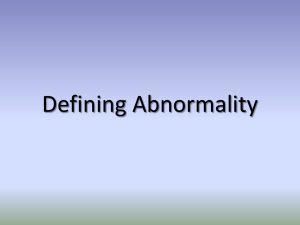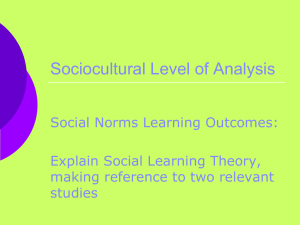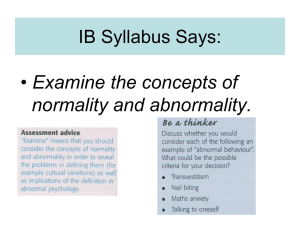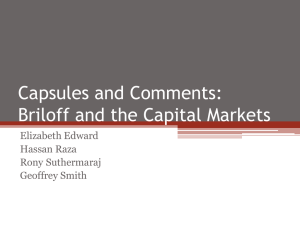PowerPoint 1
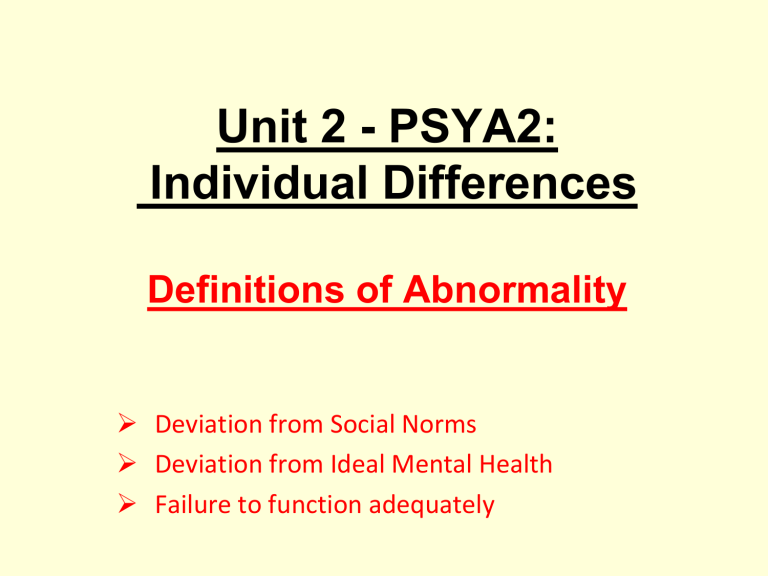
Unit 2 - PSYA2:
Individual Differences
Definitions of Abnormality
Deviation from Social Norms
Deviation from Ideal Mental Health
Failure to function adequately
Normal or abnormal?
“ Deviation from social norms ”…
Every society sets up rules. They can be…
Explicit ‘rules’…
Violating explicit rules means breaking the law e.g. arson, taking drugs…
People who violate explicit rules are criminal
Implicit ‘rules’…
These are unspoken & conventional e.g. Standing too close to someone
People who violate implicit rules are deviant
Since rules become established as ‘norms’, anyone who deviates from these can be seen as ‘abnormal’ if we accept this definition …
Eye on the
Real life Application of
Deviation from social norms…
exam: You could be asked to apply your knowledge to a person’s behaviour…
NAME:
EXPLAIN:
APPLY:
Tiger Woods has violated both explicit & implicit rules
E.g. he has committed adultery (explicit) & could therefore be considered ‘criminal’. He has also broken unspoken rules about relationships (implicit) & can therefore be seen as ‘deviant’
Since he has violated these rules that have become
‘norms’ Tiger Woods can be regarded as ‘abnormal’, if
we accept this definition.
Evaluation (Ao2)
In your group, discuss what you think the strengths & limitations are for this definition of abnormality.
One member of your group needs to list the discussion points on the mini whiteboard provided.
You will feedback your ideas to the rest of the class.
AO2: STRENGTHS of
“
Deviation from Social Norms
”
Since social norms identify behaviours that are ‘desirable’ (ideally) for the individual and society, this definition allows us to assess the desirability of a behaviour. Deviance from social norms is viewed as undesirable.
.
This definition also takes into account the effect that behaviour has on others. Deviance is defined in terms of ‘breaking social rules’ & these rules are established to help people live together. Deviant behaviour is socially unacceptable as it is damaging to the social rules that bind society together.
Deviation can
promote social change
Social deviancy is not necessarily a bad thing. Some people may choose to live an alternative, non-conformist lifestyle. Others are socially deviant because their behaviour is motivated by high principles e.g. opposition to an oppressive government.
Often social deviance is the catalyst for social change .
AO2: LIMITATIONS of
“
Deviation from Social Norms
”
We cannot accept that deviating from social norms ALWAYS means being abnormal. There are limitations/criticisms of this definition
Eccentric or abnormal?
Sometimes, behaviour that deviates away from the norm is more ECCENTRIC than abnormal.
For example, someone running a marathon dressed as a giant armadillo we may think is a bit strange or eccentric, but not psychologically abnormal. However, eccentricity may be abnormal if it is severe enough.
Abnormal or Criminal?
People who violate legal norms are usually regarded as showing criminal (deviant) behaviour, but stealing cars is rarely due to underlying psychological disorder.
Other criminals e.g. serial killers, are more likely to be viewed as abnormal & having an inbuilt fault in their personality. ‘Normal’ people couldn’t commit such crimes.
The severity/magnitude of the behaviour is important when defining abnormality using deviation from the norm.
The role of
context
…
We must remember that much of our behaviour is context-specific, and if taken OUT OF CONTEXT then it might see odd or abnormal.
For example, it might be normal to jump up and down screaming orders at people (if you are a spectator at a football match and you are shouting at the players)…but taken out of context, if we did that at the opera, or in the supermarket then it would be abnormal
Change with the times…
Society’s beliefs about what is abnormal changes over time . What is thought of as deviant by one generation, might not be by the next.
For example, before the 20 th century, unmarried women in the UK who had babies were sent to mental institutions and their babies put up for adoption. So we cannot just accept that deviating from social norms means we are abnormal
A way of excluding non conformists from society e.g. homosexuality – ‘susceptible to abuse’
Cultural Issues…
We can’t make the assumption that what we see as abnormal in our culture should be classed as abnormal in others, and vice versa. These are with this definition.
cultural issues
For example, talking out loud to an invisible person is abnormal in our culture, but often quite normal in some African and
Indian cultures following a bereavement.
Summary of
Deviation from Social Norms
This definition suggests that we can be defined as abnormal if…
• we break either explicit or implicit rules that have become ‘norms’ in the society we live in
Strengths of this definition are…
• It allows us to assess the DESIRABILITY of a behaviour – help people live together.
• It can promote SOCIAL CHANGE
L imitations of this definition are…
•
Our behaviour might be ECCENTRIC, not abnormal
• It might just seem abnormal if TAKEN OUT OF CONTEXT
• Social Norms CHANGE OVER TIME
• Social Norms are different across CULTURES
Brain Break …
Spend 10 minutes with some of the new activities!
“ Deviation from social norms ”…
Every society sets up rules. They can be…
E______ ‘rules’…
Violating explicit rules means breaking the law e.g. arson, taking drugs…
People who violate explicit rules are _______
I______ ‘rules’…
These are unspoken & conventional e.g. Standing too close to someone
People who violate implicit rules are _______
Since rules become established as ‘________’, anyone who deviates from these can be seen as ‘abnormal’ if we accept this definition …
Real life Application of
Deviation from social norms…
Eye on the exam: You could be asked to apply your knowledge to a person’s behaviour…
NAME:
EXPLAIN:
APPLY:
Tiger Woods has violated ____________________ rules
E.g. he has committed adultery (________) & could therefore be considered ‘criminal’. He has also broken unspoken rules about relationships (____________) & can therefore be seen as ‘deviant’
Since he has violated these rules that have become
‘________’ Tiger Woods can be regarded as ‘abnormal’, if
we accept this definition.
AO2: STRENGTHS of
“
Deviation from Social Norms
”
Since social norms identify behaviours that are ‘desirable’ (ideally) for the individual and society, this approach allows us to assess the desirability of a behaviour. Deviance from social norms is viewed as undesirable.
.
This model also takes into account the effect that behaviour has on others. Deviance is defined in terms of ‘breaking social rules’ & these rules are established to help___________ ________ ________. Deviant behaviour is socially unacceptable as it is damaging to the social rules that bind society together.
Deviation can
promote social change
Social deviancy is not necessarily a bad thing. Some people may choose to live an alternative, non-conformist lifestyle. Others are socially deviant because their behaviour is motivated by high principles e.g. opposition to an oppressive government.
Often social deviance is the _______ for social ________ .
AO2: LIMITATIONS of
“
Deviation from Social Norms
”
We cannot accept that deviating from social norms ALWAYS means being abnormal. There are limitations/criticisms of this definition
Sometimes, behaviour that deviates away from the norm is more ___________ than abnormal.
For example, someone running a marathon dressed as a giant armadillo we may think is a bit strange or eccentric, but not psychologically abnormal. However, eccentricity may be abnormal if it is severe enough.
Abnormal or Criminal?
People who violate legal norms are usually regarded as showing criminal behaviour, but stealing cars is rarely due to underlying _______________ disorder.
Other criminals e.g. serial killers, are more likely to be viewed as abnormal & having an inbuilt fault in their personality. ‘Normal’ people couldn’t commit such crimes.
The severity/magnitude of the behaviour is important when defining __________ using deviation from the norm.
2 .We must remember that much of our behaviour is context-specific, and if taken ___ __ _________ then it might see odd or abnormal.
For example, it might be normal to jump up and down screaming orders at people (if you are a spectator at a football match and you are shouting at the players)…but taken out of context, if we did that at the opera, or in the supermarket then it would be abnormal
3 .
Society’s beliefs about what is
abnormal ________ _____ ____
.
What is thought of as deviant by one generation, might not be by the next.
For example, before the 20 th century, unmarried women in the UK who had babies were sent to mental institutions and their babies put up for adoption. So we cannot just accept that deviating from social norms means we are abnormal
6 . We can’t make the assumption that what we see as abnormal in our culture should be classed as abnormal in others, and vice versa. These are with this definition.
_______ _____
For example, talking out loud to an invisible person is abnormal in our culture, but often quite normal in some African and
Indian cultures following a bereavement.
Summary of
Deviation from Social Norms
This definition suggests that we can be defined as abnormal if…
• we break either explicit or implicit rules that have become ‘norms’ in the society we live in
The limitations of this definition are…
•
Our behaviour might be ECCENTRIC, not abnormal
• It might just seem abnormal if TAKEN OUT OF CONTEXT
• Social Norms CHANGE OVER TIME
• Social Norms are different across CULTURES
Brain Break …
Spend 10 minutes with some of the new activities!
Quick Quiz!
Matthew works part-time in a very respectable hotel.
After each shift he works, he goes to play football with his friends at a local park. The hotel has strict rules about staff wearing the correct uniform, so Matthew always makes sure that he wears his freshly ironed shirt and trousers, along with polished shoes.
However, sometimes he forgets his change of clothes and goes to play football in what he is wearing. His friends think he is abnormal. Is he?
“Deviation from
Ideal Mental Health ”
Considers characteristics of mental health, rather than mental
illness. According to this definition, people should ‘meet’ certain criteria to be considered ‘normal’.
Jahoda - identifies 6 characteristics associated with optimal living & ‘ideal mental health’. Therefore, anyone who deviates from this is ‘abnormal’.
R esistance to stress
A ccurate perception of reality
P ositive attitude towards the self
P ersonal autonomy
A dapting to the environment
S elf-actualization of your potential
Eye on the exam: You could be asked to apply your knowledge to a person’s behaviour…
NAME:
EXPLAIN:
APPLY:
Kerry Katona might be deviating from ‘Ideal mental health’ as she is ‘missing’ some criteria…
E.g. she has failed to master her environment (showbiz), whilst also not having a positive attitudes towards herself (see
MTV). Furthermore, she seems unable to resist stress (see any of the arguments she has with Mark).
Since Kerry fails to ‘tick’ some of the criteria of ‘Ideal mental health’ she could be considered ‘abnormal’.
Evaluation (Ao2)
In pairs, brainstorm what you think the strengths & limitations are for this definition of abnormality.
Discuss your ideas with another pair.
AO2: LIMITATIONS of
“
Deviation from Ideal Mental Health
”
This approach is refreshing as it focuses on positive, rather than negative aspects of life. But to meet all 6 criteria is quite demanding, and therefore most people will fall short of ‘ideal mental health’
•
•
•
It is difficult to ‘self-actualize’ as very few people meet their full potential in life.
There are possible benefits to stress, as some people work better under moderate stress.
There are cultural issues as Jahoda’s ideas are based on Western ideals evident in some cultures but not others
You must APPLY these weaknesses with more detail, explaining why they criticise the definition
“
Failure to function adequately
”
• Based on the idea that everyone should be able to make a contribution to society.
People with psychological disorders often experience suffering & distress and are unable to cope with their everyday activities
• When diagnosing mental disorders, Dr’s are required to take this into account. One measure used is the
‘DSM’, however the Global Assessment of Functioning
Scale (GAF) assesses people on physical & psychological measures.
Rosenhan & Seligman suggest 7 criteria that indicate a failure to function adequately. The more criteria a person meets, the more severe their abnormal behaviour is considered to be
Suffering
Maladaptiveness
Unpredictability
Observer discomfort
Unconventionality
Irrationality
Violation of moral standards
- e.g. anxiety disorders
- preventing you getting on with life
- e.g. mood swings
- behaviour making others uncomfortable
- different from others behaviour
others can’t understand why
- going against moral standards
Rosenhan & Seligman argued that each might not be significant on its own but, when several were present, they are indicative of abnormality.
Real life application of Failure to
Function Adequately
Eye on the exam: You could be asked to apply your knowledge to a person’s behaviour…
NAME:
Michael Jackson might have been failing to function adequately as he was causing distress both to himself and others…
EXPLAIN:
E.g. his behaviour had become progressively unpredictable, whilst his behaviour also caused observer discomfort (e.g. swinging ‘blanket’ over a balcony). Furthermore, he sometimes acted unconventionally (e.g. sleeping in an oxygen tank) and he sometimes behaved irrationally (e.g. by making his children wear masks for fear of contamination)
APPLY:
Since Michael ‘achieved’ some of the criteria of
‘failure to function adequately’ he could have been considered ‘abnormal’ .
Evaluation (Ao2)
Discuss what you think the strengths & limitations are for this definition of abnormality.
•
•
•
•
•
AO2: LIMITATIONS of
“
Failure to function adequately
”
Not the whole picture: It does not really define abnormality, it just determines the extent of a persons problems and the likelihood of them needing professional help
Who judges? Someone needs to determine if this is the case.
Exceptions to the rule: sometimes people behave uncharacteristically or inadequately, but this does not make them abnormal
Adaptive or maladaptive?
Some dysfunctional behaviour can be adaptive/functional for the individual e.g. transvestitism is classed as mental disorder but the individual may make a living out of it.
Direction of causality: the inability to cope with life might be the cause of a mental disorder, not always a symptom of one
Evaluation (Ao2)
The 3 approaches to defining abnormality share several strengths & limitations.
Can you identify these strengths & limitations?
Evaluation (Ao2)
The 3 approaches to defining abnormality share strengths & limitations e.g.
+ve: A gateway to treatment – help lay people to decide whether to seek professional help if they or others are concerned about deviant behaviour, failure to function or deviation from ideal mental health.
-ve: Relating definitions to changing contexts & times
-ve: Cultural limitations – open to cultural bias
Deviation from Social
Norms
Explicit & implicit rules of society are norms …breaking them is ‘abnormal’ behaviour
Failure to function adequately
Being unable to function on an adequate level in the society we live in is
‘abnormal’ behaviour
Defining
BUT this could be just eccentric behaviour, or taken out of context to appear abnormal. It could also be culturally and historically dependent.
Abnormality
Deviation from
Ideal Mental Health
R esistance to stress
A ccurate perception of reality
P ositive attitude towards the self
P ersonal autonomy
A dapting to the environment
S elf-actualization
… 6 criteria of ideal mental health
BUT, failing to function adequately is not always the whole picture. There are often exceptions to the rule. This definition is both Era and Context dependent, and the Direction of causality – cultural issues
BUT to meet all 6 criteria is quite demanding, and therefore most people will fall short of
‘ideal mental health’
Typical examination questions …
• Outline two definitions of abnormality
(3+3 marks)
• Explain one limitation of the
???
definition of abnormality
(3 marks)
• Using your knowledge of psychology, explain how
???
may be considered ‘abnormal’
(4 marks)
• Outline and evaluate two or more definitions of abnormality
(8,10 or 12 marks)

